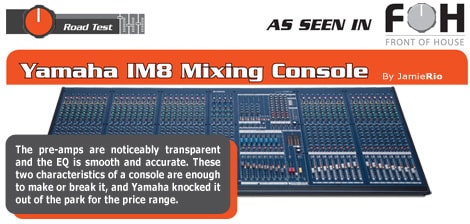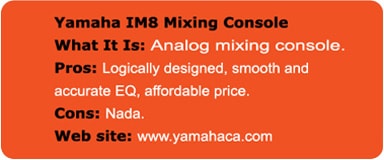Yamaha IM8 Analog Mixer FOH Road Test
 |
||
|
Yamaha IM8 Analog Mixer Front of House ROAD TEST |
||
|
I first had a look at the IM8 at the 2008 winter NAMM show. John Schauer from Yamaha led me to the secret room where the
not-yet-released board was waiting. Ya-maha is not the only manufacturer that likes to keep their new products undercover until the
moment of re-lease. Just about every mixing con-sole manufacturer conceals their new hardware until they are ready. What-ever the
reasoning behind Yamaha's motives, John was definitely in secret-agent mode at NAMM. He told me that this console was designed with
houses of worship in mind. It has enough bells and whistles to satisfy a variety of mix-ing demands and is still very simple to
operate. However, as I looked over the board, I thought it would work well in an array of operations outside of wor-ship.
I think this may be a good time to mention that this mixing console is built in the same factory as the PM boards. Just knowing this bit of in-formation leads me to believe that this console is a well thought-out, de-signed and built console. THE GEAR
All mono channels have both bal-anced XLR and TRS input jacks (Ste-reo channels have unbalanced stereo phone jacks and RCA
jacks). You will also find one insert I/O and one direct out jack per mono channel. A +48-volt switch turns phantom power on and off
at each mono channel followed by a 26-dB pad switch. The channel gain knob ranges from 60 dB to16 dB un-less the pad switch is
engaged. In this case, the gain knob ranges from -34 dB to +10 dB. Stereo channel gain oper-ates in the -34 dB to +10 dB range. The
phase switch can come in handy and, of course, there is an 80-Hz high pass filter switch. Every mono channel also sports a one-knob
compressor. Com-pression can incorporate a lot of com-plex parameters, but the Yamaha techs have squeezed them into one knob.
The four-band equalizer is next.Both mono and stereo channel high EQ and low EQ are fixed at 10 kHz and 100 Hz. Mono channels have sweepable hi-mid and low-mid, and stereo channels have their hi-mid fixed at 3 kHz and low-mid fixed at 800 Hz. All stereo and mono channels have eight individual aux sends. They are grouped in pairs for pre-fader and post-fader operations. The channel pan knob (mono) will get you into any of the eight groups or just send you left or right. The balance knob (stereo) adjusts the signal volume balance. The left input jack can be sent to the odd channel of the group or the left ste-reo bus and the right input jack can be sent to the even channels or right stereo bus. Input meters (mono and stereo) are made up of three LEDs and enable you to see if you are cruising along or slam-ming the channel input. Bus assign switches direct the signal to groups 1/2 to 7/8 or the stereo or mono bus. You can mute your individual channel or assign it to the 1-4 master mutes to create up to four different mute con-figurations. This is a cool little feature. Of course, smooth, long faders are on board for each channel. Besides where would we be without a pre-fader lis-tening switch (PFL)? |
The master section is well thought-out beginning with the four stereo aux returns. These returns can be sent to the eight group,
stereo or mono bus via the bus assign switches. Each aux re-turn has a level knob and a PFL switch. The aux sends are routed
through eight faders with LEDs and AFL switch-es. Just right of the aux returns are 2-track stereo/mono in/USB section. Here you
can choose from RCA, USB and mini-plug inputs plus RCA, USB record outputs. The master group fad-ers have on/off switches, LEDs,
mono and stereo routing switches and AFL switches.
The matrix section gives you four matrix outs fed from the groups, ste-reo and mono bus - very handy for those extra outputs. They also have rotary level control knobs and AFL switches. Next to the matrix section are the four mute master switches. The talkback section lets you route your talkback signal just about everywhere: auxes, groups, stereo/mono or through the matrix outs. Of course, you have a level knob and on/off switch. The mas-ter stereo out incorporates two faders PFL and AFL switches, an on/off switch and a stereo LED meter. There is also a separate mono master fader out. Not to be forgotten is the monitor section with its LED meters, PFL/AFL, monitor and phone level rotary knobs. One last note on the stereo and mono master outs: They both sport insert I/Os for throwing of a graphic EQ of whatever. THE GIG
My biggest gig with the IM8 was at a Billy Vera show. I was testing the 32-channel chassis using 28 of those channels. The first
thing that comes to mind is that the mixer is designed very logically. When I am using a new con-sole, I don't want to think
too much about the hardware - I want knobs, switches and faders to be where I ex-pect them and important ones in obvi-ous color
displays. Yamaha did a good job with this mixer's overall design. The pre-amps are noticeably transpar-ent and the EQ is smooth and
accurate. These two characteristics of a console are enough to make or break it, and Yamaha knocked it out of the park for the
price range.
I was uncertain about the one-knob compression, but it worked well and came in handy for things like bass and drums. Having the compression knob right there without having to patch anything in is sweet. I was mix-ing monitors from FOH at this gig and having a good amount of aux sends made things easier. Also, the faders on the aux sends made adjustments more accurate. I had two drummers at this gig, so the sub-groups were a must. In addition, both drummers did not always play at the same time, in which case master mutes came in handy. Also worth mentioning is that the mixer feels solid. That may be a hard concept to get across, but it is the dif-ference between working with a pro piece of equipment and a toy. Billy has four horn players (two trumpets and two saxes), and once again, the onboard compression was invaluable with this section (not to mention the sub-groups). I think Yamaha will be able to fill a whole lot of mixing needs and scenarios (over and above wor-ship sound) with this console, and at this price point, it is available to just about anyone who wants it. 
|
|

